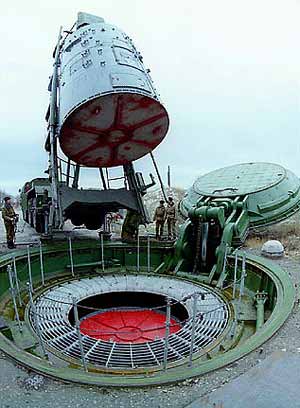24.02.2009
February 11, 2009 (the date of publication in Russian)
Maxim Kalashnikov
DOES RUSSIA NEED A DISARMAMENT RACE?
Nuclear disarmament is expedient for the United States and China but not for Russia
 US President Barack Obama is addressing Russia with an ostensibly peaceful and humanistic proposal of a mutual reduction of nuclear arsenals. The number of nuclear charges is supposed to be slashed to 1000 from each side, i.e. by 80%.
US President Barack Obama is addressing Russia with an ostensibly peaceful and humanistic proposal of a mutual reduction of nuclear arsenals. The number of nuclear charges is supposed to be slashed to 1000 from each side, i.e. by 80%.
Obama's message supposes that the United States and Russia are in equal need of protecting themselves from potential adversaries. However, the geographical position of the two powers cannot be equalized.
Both Russia and the United States have access to two oceans. However, the United States doesn't have any serious potential adversaries on the same continent. In the Americas, the United States is a single nuclear power, while Russia is one of the many states in Eurasia where military nuclear technologies continue to spread.
The population of the United States and Russia is comparable. However, the territories of the two countries much differ in size and shape, as well as in development of transport infrastructure. The US territory cannot be disrupted into parts in case of an offensive across the southern (land) border. The United States does not have any neighbors with a population exceeding it by an order.
Beside these two objective aspects of inequality, the United States and Russia are unequal in the current technological level and physical condition of armaments in a whole. Firstly, the United States has used its favorable geographic potential for developing a powerful Navy which is the strongest in the world, and includes most advanced aircraft carriers and submarines. Secondly, the US military industrial complex holds the cards in non-nuclear high precision weapons. Thirdly, Americans possess an integrated system of ABM defense. In case of decrease of nuclear armaments, they'll be able to efficiently economize on upgrading this system.
The United States has derived this advantage from degradation of the Russian system of military science, technologies, and labor force since the disintegration of the USSR which itself disrupted a number of crucial production cycles in military industry. The Americans are pretty aware that only in the latest period, between 2000 and 2008, the total number of strategic nuclear charges has declined from 5842 to 2498 items (by 42.75%), while the number of strategic nuclear missiles reduced by 405 (34.76%). During this period, the Russian Armed Forces has amortized 440 land- and sea-based missiles, and two TU-95MC strategic bombers, while one TU-160 crashed, and one more strategic border, TU-22M3, was downed during the war conflict in Georgia. For the same period, the Russian military received only 27 new ballistic missiles of the Topol M type, and not a single cruise missile.
Meanwhile, RS-18 and RS-20 missiles, with repeatedly extended in-commission rate, are going to be amortized in the nearest time. Their effective life cannot be extended again for the same reason of the disintegration of the Soviet defense system. In the USSR, they were produced in Dnepropetrovsk, Ukraine. At present, the government of Ukraine refuses to continue servicing these missiles. Their replacement for a Silo version of Topol is inadequate, as Topol carries only one nuclear warhead. The possibility of constructing a multiple warhead version of Topol, known as RS-24, is doubtful. The RS-18 missile carries 4.3 tons and RS-20 – 8.8 tons of throw-weight. Meanwhile, the Topol missile carries only 1 ton, and the Topol M version – 1.2 tons. This means that a multiple warhead version can carry only a small number of low-yield warheads, with no possibility of installing anti-ABM equipment. In fact, Topol was originally designed as a single-charge missile, and correction of this design can only reduce its technological capabilities.
Production of ballistic missiles is currently reduced to two plants. One of them tried to master manufacture of the Bulava-type missile for submarines, but failed this mission. Thus, the prospect of losing most of the arsenal of ABMs, with only a few single-charge Topols left, is quite realistic.
Under these basic conditions, disarmament for Russia is equal to dismantling before an adversary armed cap-a-pie. Replacement of nuclear missiles with non-nuclear armaments is much more expensive in terms of the efficiency/costs ratio than production of new nuclear missiles, especially given the current shape of the Russian economy.
The alternative option – to let off the leash, and allow the United States to produce as many nuclear warheads as it likes – makes much more sense for Russia. Even in case the number of US warheads is 10 times larger than ours, it will be sufficient for Russia to retain a military nuclear potential for being able to disrupt the ABM system of the opposite side, and to deliver a fatal blow to NATO or any other potential adversary. We should assess this problem soberly: unlike the times of the arms race of 1980s, our nation is not going to benefit from disarmament in any aspect.
Agreements a la Gorbachov will not solve the problem of the Russian military capacity. At the same time, if the current situation in military technologies is not changed, Russia is likely to eventually become a very vulnerable "nuclear dwarf". The only adequate response to the current challenges is to develop a new class of relatively cheap high precision non-nuclear missiles, enabling to adequately repel a potential assault from any aggressor.
Number of shows: 2031
 ENG
ENG 

 ENG
ENG 
